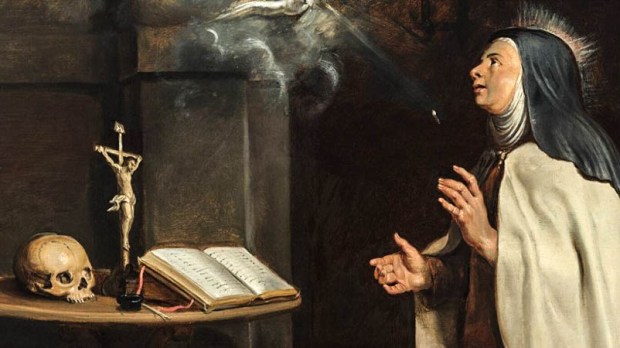October 15 is the feast of St. Teresa of Ávila (1515-1582), probably the female saint and mystic with the greatest influence in the world.
For the feast of St. Teresa of Avila, we decided to ask a Carmelite why this saint—a Doctor of the Church, representing the culmination of Christian mysticism—is relevant and useful for new generations.
So we turned to Sr. Cristiana Dobner, one of the most prolific Carmelite nuns and Catholic women today. She translates German, English, French, Spanish, Dutch, Hebrew, and Russian, and is a contributor to various publications, including the Vatican’s semi-official newspaper, L’Osservatore Romano. She lives in the monastery of Santa Maria del Monte Carmelo in Concenedo di Barzio, in the northern Italian city of Lecco. She knows, reads, translates, and writes about St. Teresa.
“Just being a woman is enough for my wings to fall off,” St. Teresa said. This statement, written in her autobiography, is one of the famous sayings of this great saint, whose full name was Teresa de Cepeda y Ahumada. According to Sr. Dobner, this phrase reminds us that despite the social conventions at the time that clipped the wings of women, Teresa would not let herself be held back.
In the world of the Spanish Golden Age, society was not very inclined to the “independence of women; rather, it was just the opposite. Men were in control, and women had to adapt,” explained the Italian Carmelite, who explains how, from an early age, Teresa “showed that she knew how to get what she wanted.”
“Teresa was fascinated by hearing and reading stories about the martyrs, because they had shed their blood and had seen God. And she, in order to see Him, wanted to speed up time. In fact, she convinced her younger brother Rodrigo to run away with her to Muslim lands, so they could be martyred and, in this way, would be able to see God. Their family members found them just outside their home town of Avila. But that was Teresa, and that was her determination as a young girl.
“Just imagine what she was like as an adolescent, or as an adult,” Dobner says.
So to get to know this saint better for her feast day, here are a dozen interesting facts about the saint:
- She felt that a day when she couldn’t read a new book was a day lost.
- With the complicity of her mother and behind the back of her strict father, she read books about the great deeds of knights, which were very popular at the time.
- There are hypotheses that suggest that Teresa was part of a network of women who exchanged books.
- She was independent and autonomous. When she understood that God was calling her to be a nun, and after she told her father (who rejected the idea), she decided to leave her parents’ house, and she went to the monastery of the Incarnation (in Avila).
- The day she entered the monastery (November 2, 1535), the bells were ringing for All Souls day.
- She overcame bureaucratic and economic obstacles—and, Dobner says, also the male chauvinism of the time—and managed to found new convents.
- She established small convents throughout Spain. She traveled on foot, and thus became called the “walking” (“andariega”) saint.
- She taught her nuns to think and pray on their own, and to concentrate in order to hear the Lord in their interior, in what she called the “Interior Castle.”
- She was closely watched because she was suspected of heresy, but they couldn’t find anything that contradicted the idea that she was obeying God’s will.
- She always abandoned herself to God’s will, and was a very determined woman who knew where she was going. She often used to say, “I am yours, Lord; I was born for You. What do you want from me?”
- In 1970, together with Saint Catherine of Siena, she was declared a Doctor of the Church.
- As she herself admitted, sometimes she felt like “a lion,” and other times like “an ant.”

